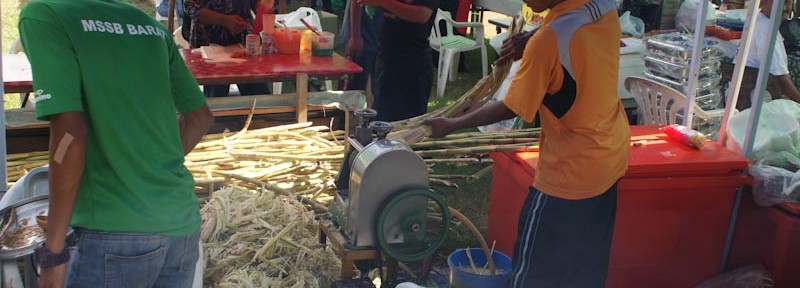FoodieBah and I visited our first bazaar of the Ramadan season today, driving out all the way to Lok Kawi Army Camp to experience the popular market there.
The Lok Kawi Ramadan Market is notable, because servicemen and their families from all over Malaysia make and sell speciality dishes unique to their home-towns at this bazaar.
Lok Kawi Army Camp Ramadan Bazaar
We arrive there around 3pm with the Lok Kawi Ramadan Bazaar already humming and the cars of plenty of other eager food shoppers lining the side of the road.
You can see the smoke from various BBQ pits cooking chicken, lamb and beef rising as you drive up, confirming that you’ve arrived at the right location.
 FoodieBah heads straight for the stall she knows will be the busiest and most sought after – the nasi kerabu.
FoodieBah heads straight for the stall she knows will be the busiest and most sought after – the nasi kerabu.
Sure enough, when we get there, the stall has already attracted a crowd, and we join the 20 odd people in a rough formation, each silently willing the stall owner to make eye contact and notice that we want to order.
Nasi kerabu is a rice dish with origins in the states of Kelantan and Terengganu.
The distinctive blue rice, which obtains its colour from the Telang flower it is cooked with, is usually served with dried fish or fried chicken. At this stall, it’s fried chicken.
Condiments like crackers, pickles and salad accompanies the dish.
After about 10 to 12 minutes of quietly and patiently waiting for the “production line” to finish assembling the various portions, we collect our first dish and add it to our buka puasa collection bag.
Popular Local Ramadan Food & Drinks
Colourful tubs of drinks and trays of sweet desserts has started to line the narrow isles of low canopies in the meantime. The market covers an area roughly the size of half a football field and we start to explore.
 I stumble across another busy looking stall with people mulling in front of it (no space to queue). “Putu Piring” says the sign above the stall.
I stumble across another busy looking stall with people mulling in front of it (no space to queue). “Putu Piring” says the sign above the stall.
It’s grated coconut with brown sugar, both fresh and sweet, so I think it’s meant to be a dessert. Lots of people want to get their hands on this little treat and later, after tasting it, I realise it’s quite delicious.
Exploring further we come across a huge BBQ pit with perhaps 2 dozen quarter chickens flame grilling, which the owner says – if I understood correctly – is for his version of nasi ayam penyet. Nando’s comes to mind.
 We also discover multiple stalls selling murtabak, a type of savory, veggie-or-meat filled pancake.
We also discover multiple stalls selling murtabak, a type of savory, veggie-or-meat filled pancake.
Because there’s a lot of competition for this particular food, the stall owners each have a rhyme or catch phrase, which they almost sing to attract attention.
It gives the market a lively atmosphere and makes people smile, even though the heat under the canopies wants to melt that smile right off.
By the time we make it back to the centre of the market near the entrance, we’re well hot and stop to try a few of the colourful drinks.
Lots of food, but nobody’s eating
Most of the stall owners are Muslim, so in-spite of all the food, they are not eating. Therefore, non-Muslim visitors to the market generally do not consume the food they buy on the spot, but instead take it elsewhere to eat.
But, assures the Muslim stall owner that sells us the drinks, drinking for non-Muslims wouldn’t be considered offensive. I duly buy and drink two colourful drinks – a very pink Air Bandung and a very green Katira, that tastes like chendol – if ever you’ve had that.
 They are both sweet and, in the heat, go down well.
They are both sweet and, in the heat, go down well.
By now the market has swelled with visitors and the narrow isles between the canopies are heating up and getting hard to navigate. Our buka puasa bag is brimming with food for later, so we decide to call it a day.
The Lok Kawi Ramadan Bazaar is about 15km outside of Kota Kinabalu and, depending on traffic, will take about 30 minutes by taxi and should cost around RM40.
It’s well worth a visit for tourists and a great opportunity to sample traditional and modern Mulsim fare during the month of Ramadan.
The breaking of fast in Sabah takes place at 18:35, so most people will rush to buy food and get back in time to make that deadline.
